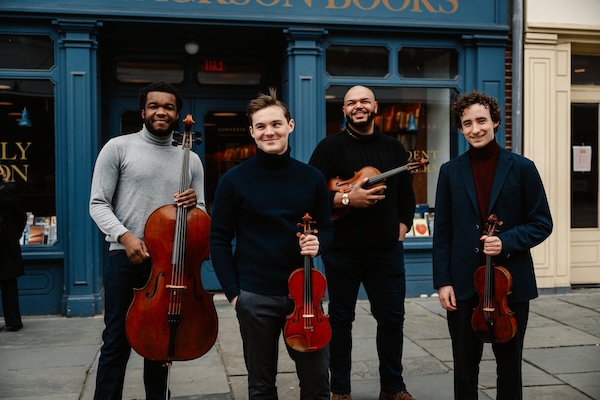In Celebrity Series debut, Isidore Quartet finds meaning in small details

The Isidore String Quartet made its Celebrity Series debut Wednesday night at Pickman Hall. Photo: Jiyang Chen
Not every concert does, or should, offer a moral. And perhaps gifting the audience one wasn’t the ultimate goal of the Isidore String Quartet’s Celebrity Series debut program Wednesday night at the Longy School’s Pickman Hall.
Still, given the excellence and concentration of the night’s performances, it was hard to escape the feeling that there wasn’t a larger purpose to the New York City-based tetrad’s lineup of works by Franz Josef Haydn, Ludwig van Beethoven, and Billy Childs than met the eye. To wit: even the loftiest art is rooted in the commonplace and extraordinary meaning and power can be found in the smallest and simplest of, in this case, musical objects.
The notion is as much at the heart of Haydn’s C-major String Quartet No. 25 and Beethoven’s epic, A-minor Op. 132 as it is in Childs’ Second Quartet (“Awakenings”). Written in 2012, the score relates, in a turbulent twenty minutes, the composer’s experience with his wife’s diagnosis of a pulmonary embolism. And, as violist Devin Moore mentioned to the house in pre-performance remarks, each of the work’s three movements can be understood programmatically.
Yet the musical content is so potent one hardly requires extra-musical guideposts. While the first movement’s jagged, scurrying lines, periodically interrupted by moments of numb reflection, convey all the shock and disorientation of an unexpected midnight phone call, they also form a packed, cogent musical argument.
Similarly, the moments of delicacy that peek through spots of furious aggression in the second offer, more broadly, glimpses of hope amid uncertainty. Though the triadic resolution to the closing, soulful “Song of Healing” borders on cliche, the resolution is at least earned, particularly via the soaring violin-cello duet around the movement’s middle.
Wednesday’s performance of “Awakenings” from the Banff Competition-winning ensemble (who are also 2023 Avery Fisher Career Grant laureates) was intense and thrillingly secure. The Isidore’s dovetailing of driving motives in the first movement, for instance, was astonishingly precise. So were the group’s perfectly calibrated balances during the finale.
Most striking, though, was their articulate projection in the central “The White Room,” especially the series of artificial harmonics passed, hocket-like, first between viola and cello, and later taken up by the violins. Whether this gesture was meant to convey the beeping of hospital machinery, a pulse, or something else is immaterial; it proved to be, at its most fundamental, a puissant musical device.
Haydn’s Op. 25 quartet offers those as well. While the composer’s trademark unpredictability turns up in the first movement’s instrumentation and the Menuetto’s phrasings, this 1772 score’s most remarkable episodes emerge in the second and fourth movements.
The former, with its recitative-like passages and frequent unison scoring, is easily one of Haydn’s strangest sounding efforts. However, everything within—the harmonic structure, gestural content (which includes flippant little trill-like figure that’s gleefully tossed around the ensemble), instrumental writing—is essentially standard: it is Haydn’s inventive juxtaposition of contraries that gives the music its singular sense of character.
So, too, the finale, whose study of tension and release—a brilliant fugue played in various gradations of piano, before exploding in volume over the last section—seems, on paper, utterly straightforward. Yet, the music’s expressive impact is anything but.
That was certainly the case Wednesday in the Isidore’s exact and subtle account of this music. The finale’s first half danced like a will-o’-wisp—light, airy, barely visible— while its last pages were a picture of catharsis and liberation. Meantime, the Adagio was etched with remarkable tonal unanimity and rhythmic flexibility.
The group brought comparable attentiveness to Beethoven’s great, late-period A-minor effort. The outer movements were defined by contrasts of extremes: lean and well-balanced, generally, but stark.
So, too, the Allegro ma non tanto, whose dusky-hued opening was beautifully weighted by the Isidore’s flowing take on its rustic (and slightly dyspeptic) Trio. In the central “Heiliger Dankgesang,” the foursome’s clean-textured, pure-toned approach to the music—serene and floating in the chorale iterations, moving with spry nobility in the Andante sections—almost brought time to a standstill.
While their encore of Florence Price’s Adoration didn’t quite achieve the same level of otherworldly repose, this short, sweet selection still reinforced the evening’s overarching reminder that, in the words of Sherlock Holmes, “the little things are infinitely the most important.”
The program will be repeated 8 p.m. Thursday at Groton Hill Music Center. celebrityseries.org
Posted in Performances


